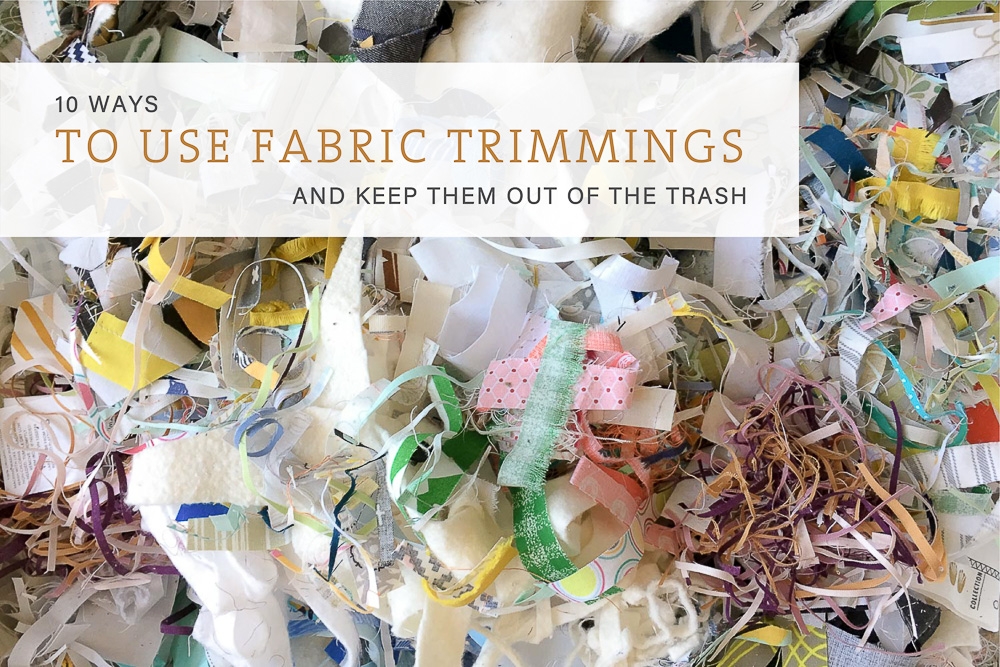10 Ways To Use Fabric Trimmings
We all have them. Even the most eco-conscious, use-every-last-bit-possible sewists end up with little heaps of them laying around. They are thread, fabric & batting offcuts that didn't quite make it into that last project: the trimmings. Not to be confused with scraps, which are bigger pieces that can be sewn back together into new 'scrap' projects, the fabric trash, or trimmings, are tricksters who love to mingle with dust bunnies on the sewing room floor, snuggle onto your black leggings (which you just knew you shouldn't have worn during last night's epic quilting sesh!) and litter your ironing board and sewing desk. Those pesky little bits you just don't know what else to do with - the parts you think can only go into the rubbish - can actually be useful! Or at the very least, they don't have to go in the trash.
1. Stuff Them
This is by far the easiest, fastest way to get rid of some of those threads and otherwise unusable trimmings. Stuff them right back into your projects! Tuck threads into quilts & bindings. Put extra cast offs into pin cushions. Make your quilt label stand out by giving it a pillow effect like Amanda at Gypsy Moon Quilts. Hide leftovers inside of pillow covers, or if you make your own pillow inserts, put them there! I even made a 15" pillow insert entirely from trimmings, when I needed an insert in a pinch. I simply sewed 2 squares of muslin together, leaving a 4" gap to stuff and sew shut. Is it heavy? Absolutely! But it's totally functional and surprisingly comfortable after 'fluffing' a few times. And it probably wouldn't be so heavy if I'd used more batting scraps and less yardage ;)
This pillow is stuffed with a form made entirely from scraps! Pattern is modified Sew Many Colors
2. Organize Sewing Needles
How many times have you lost your sewing needle into the pin cushion (me, raises both hands). Use some of those threads to tie right onto your sewing needles! you only need a few inches to loop through the eye and tie a knot at the end. Now when they get pushed too far into your cushion the thread stays visible so you can pull them right out! If you have enough different colored thread scraps, you could even color coordinate your needles and keep them in order by size & type.
3. Clean Your Machine
Those leftover batting bits and strips that you can't 'frankenbatting' together are perfect for wiping your machine down, inside and out (I usually cast anything under 3" into the 'repurpose' pile). Give it a try - you might be surprised how much lint a 1x2 inch square of batting can collect! But don't toss them after you've cleaned, because it's still a useful piece! If you don't want to use the dusty scrap for stuffing or crafting, you can jump to suggestion 9 below for another option.
4. Kid Crafts
If your kid is anything like mine, they will play happily with a strip of selvedge or batting, imagining it to be all number of different characters and objects for hours on end. But beyond that, keep your bucket of trimmings and let your kids go crazy creating craft projects with them! Just add construction paper, a gluestick, stickers, or whatever craft supplies you have on hand and I'll bet you'll all be in awe of the awesome your kids can create with your fabric trash. If your kids are younger, try using contact paper instead of glue to let them 'paste' thread and fabric together (well-supervised, of course). However you let them at it, your personalized handmade gifts for grandparents are done.
image: Village Bound Quilts
5. Textile Art
If your kids are a bit older, or if you're feeling extra crafty, use those leftovers to create your own textile art. The possibilities are truly endless, just look at some of the beautiful work that Karin Jordan created at #100daysofkjtextileart in 2017 and Heidi Parkes put together for her 30x30x30 project in 2018. Embrace the joy of improv work and the design of hand stitching here; it's the perfect way to use those smaller pieces of thread that can't wind on a bobbin.
6. Note Cards
This one is so easy and so much cheaper than buying fancy thank you cards at the store (even though I know those can be super cute). You can usually pick up a pack of 6-8 folded notecards with envelopes at your local dollar store. Just use those thread and fabric bits from your trimmings bin to add color, and voila! Custom note cards that will make the receiver feel extra special and you barely spent a dime - literally. Well, except for postage.
image: Village Bound Quilts
7. Gift Wrap
Using selvedges or extra long, thin trimmings as ribbon is a favorite way to tie up gifts, especially when they coordinate with that handmade gift you created! Tie a long ribbon of fabric around the tissue wrapped quilt, a small one on the handle of the gift bag, or simply use a piece to create a little fabric pompom to tape on that gift box. If your offcut 'ribbon' is too wonky, too short, or just too 'meh,' try this great idea by Cintia at My Poppet Makes to make those skinny strips into twine! Use it for all manner of wrapping or tying too.
And remember that handmade card you just created too? Fill it with dog ear confetti to load on the fabric fun ;)
image: My Poppet Makes
image: Pintrest
8. In The Garden
Droopy seedlings? Beans not quite climbing your trellis? Tomato plant overtaking everything? Soft garden fencing need securing? You don't need to buy fancy garden twine, just use a bit of fabric trash to tie it to their stakes! Thread, yardage or batting will all work here, rain or shine. If they start wearing out? No problem! You've got more where those came from. And when you do replace them, just toss the old pieces into your yard or your compost pile - the birds and squirrels will thank you for the nesting material (be sure to use natural fibers only, no poly or metallics).
image: Practically Functional
9. Firestarter
Making a homemade firestarter is as simple as dipping burnable material in wax. There are a ton of DIYs out there that include more 'complicated' instructions, like including sawdust and fiber egg cartons as part of the process, but really you could just wad a bunch of your old threads, fabric scraps and batting together, wrap some of that thread around it to make a short stick or ball shape, then dip in wax leaving a very small section dry to catch the first match strike. Then place it under your kindling for a low and slow burn, long enough for your fire to catch. Just be sure you're using natural materials like cotton or wool, which will burn cleaner than polyester.
10. Display
Put those pretty bits on display! Using glass jars with lids, you can display them on a shelf, or keep a pretty dish on your desk to wrangle them as you work, making that pile of trash more like a yummy bowl of color. You could even use them to decorate that rope bowl you've been meaning to make - wrap threads and fabrics around sections of rope as you sew it together. You can even use that piece of sample leather leftover, like Nicole at Modern Handcraft, or wrap random bits around rope like Laura Procter. Now they are always on display and you've made another functional, beautiful project. Win-win.
image: Whole Circle Studio
image: Laura Procter Makes
So, if you don't already have a cup, bowl or bin that you keep your project trimmings in, I'd encourage you to start saving them! You'll not only be keeping textile waste out of landfills, but you never know when you might need a little piece (or a lot) of fabric crumbs to get you through that next project.
What other ways do you use your fabric trash? Leave a note in the comments below!













